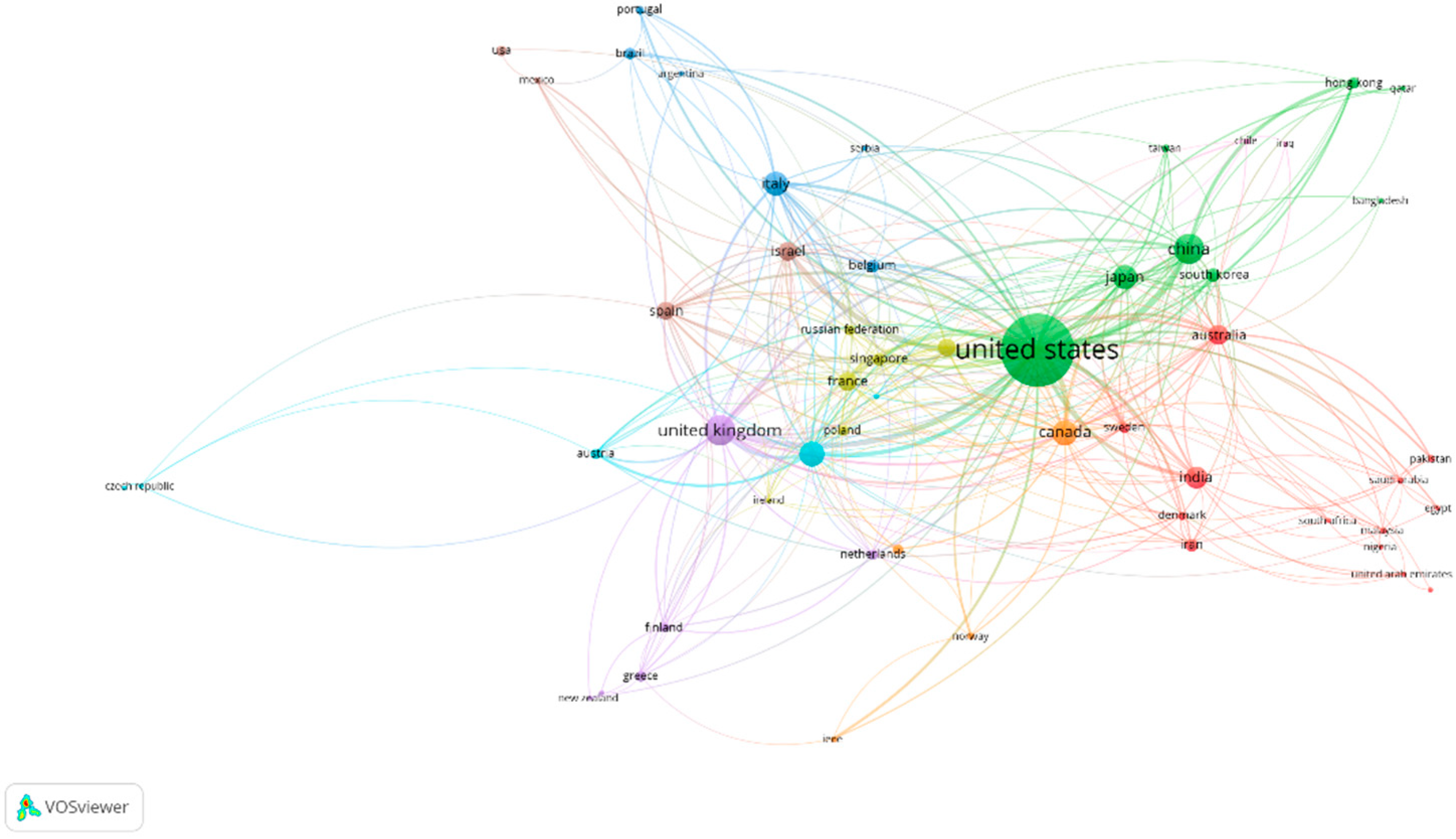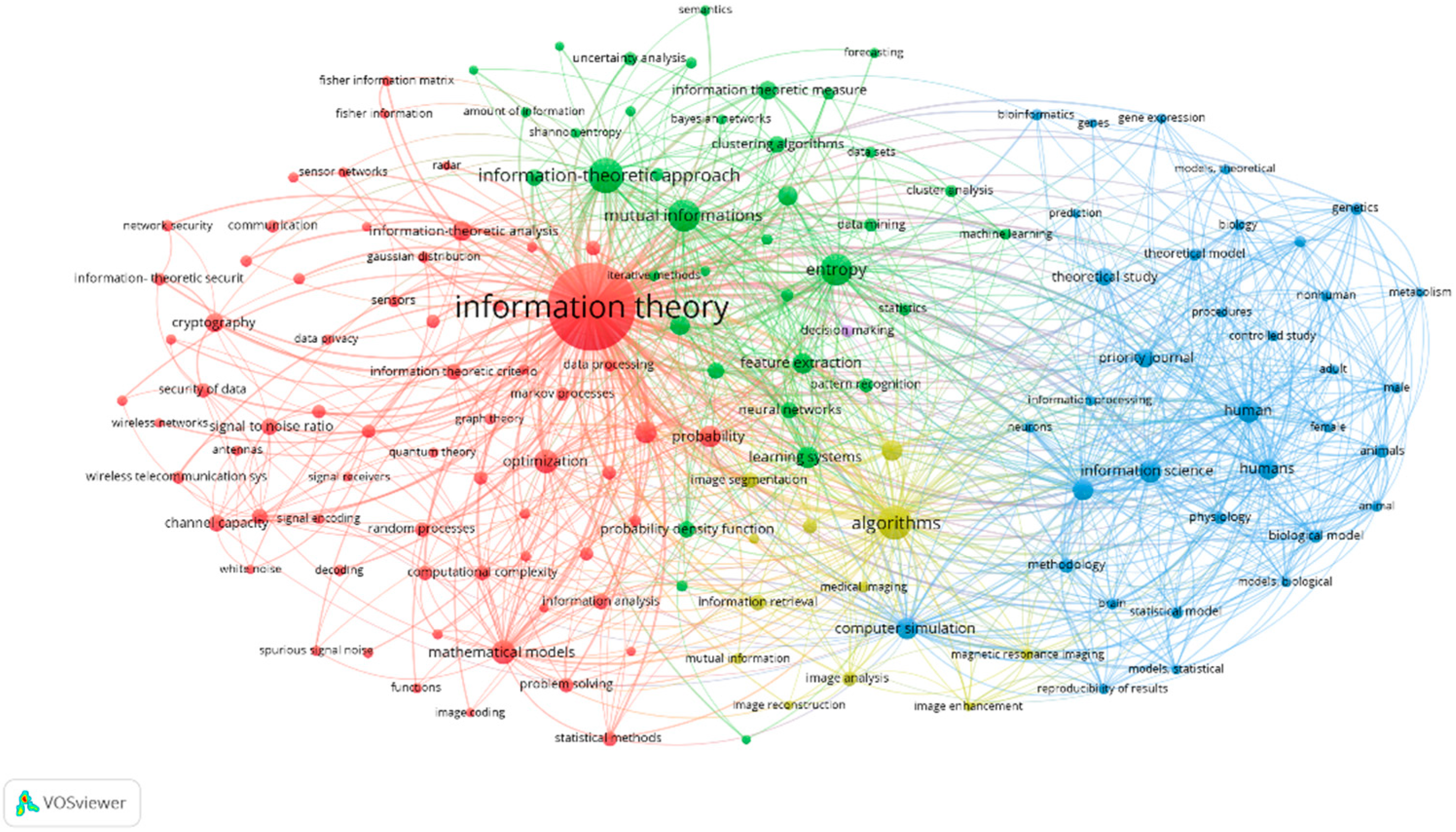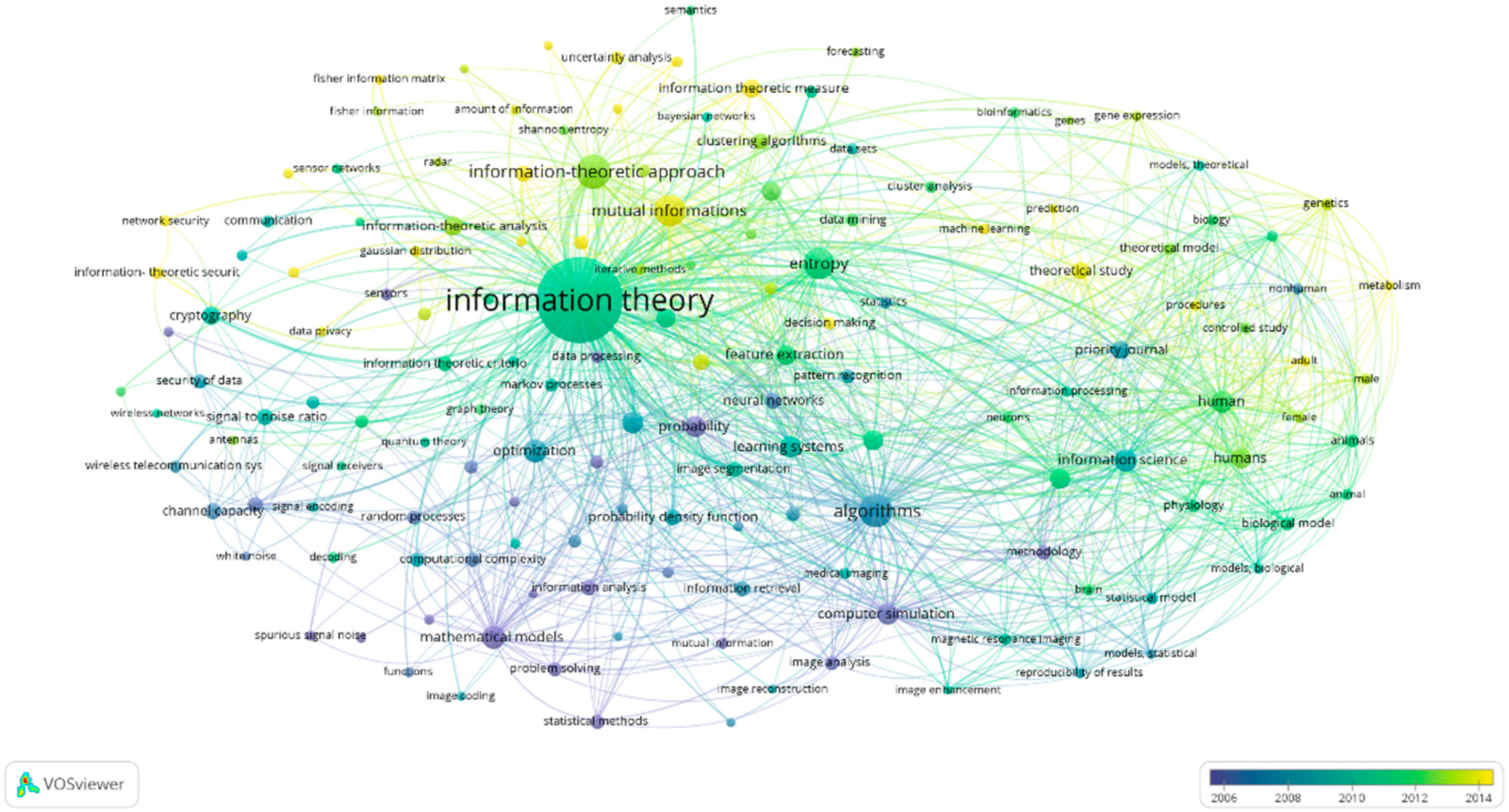This section covers the bibliometric analysis of information theoretic based on data extracted from the Scopus database. Publication growth, subject areas, geographical contributions, highly cited publications, and keyword analyses will be performed in this section. In the end, citation metrics will also be presented for a brief summary of all the 3701 publications under information theoretic, as of 17 August 2022.
3.3. Geographical Contribution of Information Theoretic Publications
Information theoretic has attracted the contributions of researchers from more than 80 countries worldwide. The United States (1624) contributes the highest to the TP, followed by China (285) and the United Kingdom (279). The total citation from the 3701 publications is 82,000. Publications from the United States have received 45,797 citations, which amounts to 55.85% of the total citation. The country with the second highest number of citations is the United Kingdom, with 7352 citations.
Meanwhile, the United States also has the highest h-index of 89. This means that 89 papers have been cited at least 89 times, signaling high scientific achievement [
21]. The United Kingdom and Germany have an h-index of 40 and 35, respectively. The highest C/P and C/CP are 41.58 and 49.46, respectively, and are contributed by Israel. Even though China has the second highest number of publications, China still needs to improve the quality of its scientific contributions.
Table 4 presents the top 10 geographical contributions of information theoretic publications.
In many publications, there is more than one researcher due to the complexity and scope of the study, which requires collaboration; co-authorship analysis assesses this research collaboration. Country co-authorship analysis portrays the level of collaboration among countries and highlights the most prominent countries in the research domain. The country co-authorship network map for information theoretic publication is shown in
Figure 2. The larger node represents more prominent countries in the research interest of information theoretic. The length between the nodes and the boldness of lines reflect the collaboration among researchers across countries. From
Figure 2, the most prominent countries active in information theoretic publications co-authorship are the United States, United Kingdom, China, Germany, Canada, France, Italy, Israel, Japan, and Australia. The United States has the highest total link strength of 490 from more than 1600 publications, followed by the United Kingdom (193), China (169), Germany (128), and Canada (127).
3.5. Most Cited Information Theoretic Publications
Table 6 tabulates the top 10 most cited publications in information theoretic since 1958. The most cited document, “Detection of signals by information theoretic criteria” by Wax and Kailath [
25], received 2731 citations and 73.81 citations per year. This paper proposed a new method to detect the amount of signal in a multi-channel time series, removing any subjective setting. The second most cited paper was “Breaking spectrum gridlock with cognitive radios: an information theoretic perspective by Goldsmith et al. [
27]. This paper discussed the use of cognitive radios for higher spectral efficiency with an information theoretic survey. The third most cited paper by Biglieri et al. [
28] found that information theoretic approaches such as equalization, coding, and modulation enhance the performances of fading dispersive channels. Davis et al. [
29] introduced an information theoretic method for learning a Mahalanobis distance function. This study showed that the proposed method could handle multiple constraints and incorporate a prior on the distance function. The following most cited paper by Bloch et al. [
30] focused on the transmission of confidential data over wireless channels. This paper developed a practical secure communication protocol to ensure wireless information-theoretic security.
Pedersen [
31] presented an efficient non-interactive scheme for verifiable secret sharing without information about the secret. Vinh et al. [
32] presented an organized study of information theoretic measures for comparing clusterings. The findings showed that the normalized information distance and normalized variation of information satisfy the normalization as well as metric properties. The next most cited paper by Dhillon et al. [
33] proposed an innovative co-clustering algorithm to increase the preserved mutual information by intertwining the column and row clusterings at all stages. This paper showed that the proposed algorithm performed well, especially in the presence of high-dimensionality and sparsity. Ozarow et al. [
34] presented an information theoretic analysis associated with digital cellular radio that focused on time division multiple access protocols. Based on the information theoretic point of view, double ray propagation was advantageous over a single ray propagation when both normalized to the same power. The tenth most cited paper by Brown et al. [
35] proposed a unifying framework for information theoretic feature selection. This paper showed that common heuristics for information-based feature selection are approximate iterative maximizers of the conditional likelihood.
3.6. Keyword Analyses
This subsection includes various keyword analyses such as the keyword co-occurrence network and keyword overlay visualization maps. Keyword co-occurrence provides research highlights of the title under study. In all the 3701 documents, there are 16,828 indexed keywords as furnished by VOSviewer. One of the advantages of VOSviewer is the ability to adjust the minimum occurrences that the keywords should achieve in the visualization maps for better interpretation, clarity, and understanding. The frequency with which a keyword appears indicates its significance in the study domain. The more the keyword appears among the 3701 publications, the greater the attention placed on the research area based on the keyword, and this would also create a map with high clarity for better analysis [
36,
37,
38]. Therefore, the keyword co-occurrence map in
Figure 3 considers only keywords that have appeared more than 30 times, with 148 keywords matching the threshold and relevant to the information theoretic studies. The size of the node of a keyword reflects the weightage of the keyword in co-occurrence. The length between nodes shows the relationship strength between the nodes. As such, the shorter the length between nodes, the stronger the relationship between the nodes. The thickness of the line signifies the co-occurrences of the two keywords. The bolder the line, the higher the co-occurrences of the keywords [
24].
Nodes with similar colors are categorized as one cluster. VOSviewer classified the 148 keywords into four clusters. The first cluster involves the red nodes with keywords such as antennas, channel capacity, cryptography, data privacy, decoding, estimation, fading channels, fisher information, gaussian distribution, information theory, Markov processes, mathematical models, Monte Carlo methods, network protocols, optimization, radar, sensors, set theory, Shannon entropy, stochastic systems, and topology. The second cluster involves the green nodes with keywords such as artificial intelligence, Bayesian networks, cluster analysis, computation theory, data mining, decision making, entropy, feature extraction, forecasting, iterative methods, Kullback Leibler divergence, learning algorithms, machine learning, probability density function, probability distributions, robotics, semantics, and uncertainty analysis. Blue nodes are the third cluster. They involve bioinformatics, computational biology, computer simulation, controlled study, information science, metabolism, neurons, physiology, and theoretical model. The last cluster is yellow and includes image analysis, image enhancement, image reconstruction, image segmentation, magnetic resonance imaging, and medical imaging.
The link strength is quantitative and can be used to identify the frequencies of co-occurrence. The total link strength involves all the link strengths with other nodes [
23]. “Information theory” has the highest total link strength of 7598 and 2326 occurrences. Other nodes with high total link strengths include algorithms (2289), entropy (1488), and human (1445).
Figure 3 shows the keyword co-occurrence map of information theoretic documents, while
Table 7 presents the top 10 keywords with total link strengths.
VOSviewer also provides an overlay visualization map to analyze keyword adoption across the years to observe the trend of the research title. Based on the overlay visualization map in
Figure 4, the yellow node implies that the keyword is of current research interest. For example, current research trends in information theoretic focus on the information theoretic measure, network security, data privacy, fisher information matrix, uncertainty analysis, decision making, and machine learning. Based on these keywords, it can be forecast that future publications in information theoretic will revolve around the technological revolution to quantify and extract information from various signals. Moreover, researchers are studying to ensure useful and valuable information can be quantified while maintaining users’ and system security and privacy.













